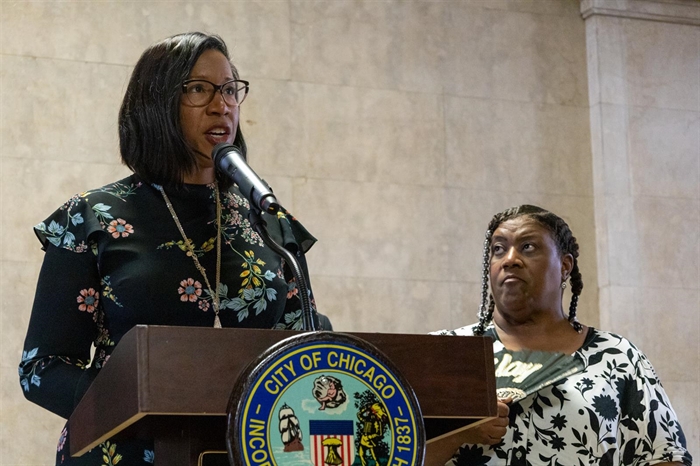(Capitol News Illinois photo by Andrew Adams)
By ANDREW ADAMS
Capitol News Illinois
Millions of Illinoisans could see higher energy bills next year, but the size of those increases will be determined by a state agency that has recently had its oversight powers expanded.
Four gas utilities and the state’s two largest electric utilities are currently requesting authority from the Illinois Commerce Commission to increase rates. Together, these companies serve 4.1 million gas customers and 5.3 million electric customers in Illinois.
All told, electric utilities have asked to raise rates by a combined $2.8 billion over four years, while gas utilities have requested $890 million in increases next year.
It’s an “unprecedented” number of proposed rate increases for one year, according to David Kolata, the former longtime head of the Citizens Utility Board, or CUB, a nonprofit organization created by the General Assembly in 1983 to represent consumers in cases like these.
The number of cases in front of the ICC is due, in part, to a pair of major policy changes affecting the way utilities request rate increases and the commission’s authority to amend those requests. For electric utilities, that means a more complicated, multi-year rate-setting process and a more thorough review of profit margins. For gas companies, that means more scrutiny of infrastructure costs.
The utilities are making their case for rate increases in an 11-month regulatory process that is set to conclude around the end of the year. But third parties like business groups and consumer advocates, in addition to ICC staff, also have a chance to weigh in before an administrative judge and eventually the five-member ICC board. The rate changes, if approved by the ICC, would take effect in January.
CUB and other consumer advocacy groups are pushing for the ICC to lower the electric utilities’ requests by at least $1.4 billion and the gas utilities’ requests by at least $231.8 million.
“Energy is essential. You can’t do anything without it,” Kolata told Capitol News Illinois prior to his recent departure from the CUB for a climate tech company. “We want to be sure we do everything we can to make our bills affordable.”
Gov. JB Pritzker has recently shaken up the board that will have the ultimate say on the rate hikes.
In March, Pritzker announced replacements for three of the five ICC commissioners. The governor tapped former ICC Chair Doug Scott to rejoin the board as a replacement for ICC Chair Carrie Zalewski, who left her role last week. The other two members took their posts earlier this year, replacing members who had either retired or saw their terms expire. Advocates hope these changes will make the board more “consumer friendly.”
And while Pritzker hasn’t weighed in on the electric cases, he wrote a March op-ed in the Chicago Sun-Times calling for increased accountability for gas companies.
“Illinois (gas) utilities want a combined $900 million in rate increases this year alone, and if no action is taken to stop it, Illinois ratepayers could be left footing the bill,” Pritzker wrote in the article published two days before he announced his new ICC appointments.
Controversial natural gas policy to sunset this year
Customers of the four gas utilities with pending rate cases – Ameren Illinois, Nicor Gas, Peoples Gas and North Shore Gas – could pay between $60 and $140 more for gas per year on average if the ICC approves their requested rates.
Infrastructure upgrades and maintenance are typically a major factor in rate increases, and for about a decade, gas utilities recouped their costs on those projects through a formula-based process that allowed them to collect – and routinely increase – a customer fee without having to go through an 11-month rate case.
Advocates say that program – referred to as the “qualified infrastructure plant,” or QIP – encouraged wasteful capital spending. For example, the consumer advocacy group Illinois PIRG says Peoples Gas’ pipeline replacement program in the Chicago area has been mismanaged and overly broad, although the utility says the program is needed to reduce safety risk.
North Shore Gas, which is owned by the same company as Peoples Gas, does not serve enough customers to charge a QIP fee to customers. Only Nicor, Ameren and Peoples Gas are large enough to do so under existing law.
The QIP program is scheduled to expire at the end of the year, giving the ICC greater authority to review the utilities’ infrastructure-related expenses and fees through the standard rate case process moving forward.
“Going back to rate cases isn’t a panacea necessarily, but it’s a better system,” CUB’s Kolata said.
Even with the expiration, Peoples Gas spokesperson David Schwartz said in an email that the infrastructure upgrades historically funded by QIP – which he called “critical for the sake of Chicagoans’ safety” – will continue. He cited an ICC study saying that the majority of Chicago’s pipes have less than 15 years of remaining life.
“Our rate filing, as an administrative matter, would just move the cost from one line of customers’ bills to a different line of the bills,” Schwartz said. He also said falling gas prices could mitigate the impact of the rate increase on consumers.
Ameren officials also noted that gas transmission upgrades, which are often federally required, will continue.
“We’re making ongoing investments in system integrity and QIP, no QIP, that commitment to safe and reliable gas delivery service doesn’t change,” Matthew Tomc, an executive at Ameren that oversees government affairs, said in an interview.
Tomc also noted that the end of the QIP fee has injected unpredictability into the infrastructure investment process.
“Going forward, I think we’re going to have to have a conversation, you know? What does the framework for gas investment look like without QIP? Is it more frequent rate filings or is there some other approach?” Tomc said.
Beyond QIP, Gas company representatives have pointed to changes in the macroeconomic landscape to explain their requested increases.
“This rate increase is necessary to run our business due to inflation and rising global impacts that continue to affect our operating and maintenance costs,” Nicor Gas spokesperson Jennifer Golz said in an email statement.
But for many in the state, the prospect of increased energy bills is daunting. In April, 12.3 percent of customers of utilities with pending rate cases had a deferred payment agreement – meaning they were more than a month behind on their bills – according to data submitted by the companies to the ICC. About 20.6 percent of Peoples Gas customers had past due bills in April, the highest number among the six utilities with pending rate cases.
Clean energy reforms in practice
On the electric side, Ameren and Commonwealth Edison’s rate plans are the first filed under a new kind of regulatory process outlined in the landmark 2021 Climate and Equitable Jobs Act, or CEJA. While the ICC’s new rate approval process is handled in a similar regulatory fashion to a traditional rate case, utilities’ requests are part of four-year plans that are considered in conjunction with a comprehensive grid plan for modernization projects.
CEJA also ended a controversial formula ratemaking process that was a product of ComEd’s lobbying efforts a decade earlier. The formula-based rates were a major focus of the recent federal criminal corruption trial that ended with the conviction of ComEd’s former CEO and three ex-lobbyists.
Consumer advocates have praised the public involvement that’s allowed in the new process and electric executives have credited the multi-year planning process for facilitating smoother coordination between setting rates and grid planning.
Kolata said the former formula-based system for setting electric rates “put a lot of things on autopilot.” The new system provides more opportunities for input and accountability, particularly as the electric sector moves toward the legislation’s goal of carbon-free energy generation by 2045, he said.
“Everyone recognizes the nature of this transition is going to require broader stakeholder involvement and feedback,” Kolata said.
ComEd’s plan would increase prices over four years, with residential customers paying around $200 per year more in electric prices by 2027. Ameren Illinois’ similar plan would result in the average residential customer paying about $300 more per year by 2027.
Louie Binswanger, who oversees regulatory affairs at ComEd, said his company’s plan includes everything from maintenance and infrastructure upgrades to outlining how the utility will prepare the grid for increased electrification, such as in the transit sector and in commercial and residential heating.
“The plan also ensures that the electric grid remains reliable and resilient for the 9 million people ComEd serves in northern Illinois as severe weather events become more common due to climate change,” Binswanger said in an email statement.
Ameren Illinois officials were similarly optimistic about their plans, noting the complexity of the new process required “a high degree of diligence.”
A point of contention between advocates and the utilities has been the electric utilities’ return on equity, or ROE. This is the main component of a utility’s profit that had, for years, been automatically calculated using a formula derived from the interest rates on 30-year Treasury bonds.
CEJA did away with this formula and placed new authority in the hands of the ICC to calculate ROE – and advocates are pushing for the commission to use it.
“The utilities are way over-asking,” Kolata said.
ComEd, in its initial January testimony, recommended a 10.5 percent ROE, up from its current ROE of about 7.85 percent. ComEd argued that the 10.5 percent ROE puts the utility in line with others in the industry.
ICC staff argued for an 8.91 percent ROE. In written testimony, they supported continuing to calculate ROE by the interest-driven formula the utilities have been using for over a decade, even though it is no longer required.
Illinois PIRG argued for an even lower 6.5 percent ROE in the ComEd case.
“These very small changes in profit rates can result in hundreds of millions of dollars in profit and higher prices for consumers,” Scarr said.
Binswanger, however, defended his company’s requested profit margin.
“Our proposed investments provide meaningful benefits to our customers and communities and support the goals of the state’s Climate and Equitable Jobs Act,” Binswanger said. “We look forward to working with the commission and all participants in the proceeding to prove that out.”
Similar arguments have been made in Ameren’s electric case, in which the utility has also asked for a 10.5 percent ROE. ICC staff recommended an 8.91 percent return on equity, calculated using the same formula tied to Treasury bonds.
Tomc argued that Ameren’s proposed formula for return on equity would be better for the electric grid.
“Those methodologies are designed to produce a number conducive to sustain the kind of investments in Illinois infrastructure that we require,” Tomc said.
Other affordability measures
In December, fulfilling another requirement of CEJA, the ICC announced that it would require large electric and gas utilities to put forward plans to offer discounted rates to low-income customers and encourage smaller utilities to do the same.
The ICC said these utilities should offer “tiered discounts for different income levels,” meaning the amount a consumer pays for utilities would be proportional to income.
While gas utilities have included rate design proposals in their current rate cases, ComEd and Ameren will file electric rate design cases separately over the coming years, according to Karen Lusson, a senior attorney at the National Consumer Law Center.
Lusson said the companies that have filed rate design cases have not gone far enough in lowering prices for low-income customers.
“Each gas company has interpreted that directive a bit differently and all of them insufficient in the amount of the discount,” Lusson said.
Naomi Davis, founder of the environmental justice group Blacks in Green, has protested the proposed rate increases from Peoples Gas and has advocated for major affordability reforms at the Statehouse.
In response to problems faced by low-income utility customers, Davis and others launched a “Campaign to End Energy Poverty.”
“Salaries do not increase at the rate that these energy prices are accelerating. What is a person to do?” Davis said in an interview.
In a March committee hearing, lawmakers heard Davis and representatives of the utility industry discuss a proposed reform package that she described as a “strategic” method of achieving energy affordability despite utilities’ objections to it. While lawmakers on the House Public Utilities Committee did not vote on the package, they indicated they were open to considering it further in the future.
Each utility involved in these rate cases has programs to help low-income customers afford their bills.











